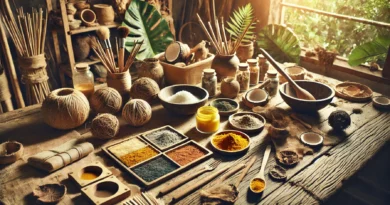Discovering the world of paper crafts: from origami to quilling
Paper crafts are one of those practices that transcend generations, cultures, and styles, while always staying relevant. With a simple sheet of paper, it’s possible to transform the ordinary into something extraordinary. Whether folding, rolling, cutting, or gluing, paper art offers endless possibilities for those who want to express themselves creatively, affordably, and sustainably.
In recent years, this practice has gained strength as a therapeutic hobby. In times of digital overload and fast-paced routines, working with your hands and creating something from scratch has become a way to slow down and focus on the present moment. It’s not just a pastime — many artisans find in this world a source of income, combining passion and work.
The most interesting thing is that paper crafts are accessible to everyone. With a few materials and some guidance, anyone can start. And within this world, there are various styles to explore. Two of the most popular — and very different from each other — are origami and quilling. Let’s understand what they are and how you can start experimenting with these techniques.
Origami: the art of folding stories
Origami is the traditional Japanese art of folding paper to create shapes that range from animals to flowers, objects, and geometric figures. The word comes from Japanese “ori” (to fold) and “kami” (paper), and the practice has existed for over a thousand years. One of the charms of origami lies in the fact that it’s made only with folds — no cutting or gluing.
Creating an origami piece requires patience, precision, and attention to detail. It may seem difficult at first, but basic models are easy to learn and ideal for beginners. One of the most famous examples is the tsuru, the bird of peace. According to tradition, whoever makes a thousand tsurus will have a wish granted.
Simple step-by-step to make a tsuru (origami bird):
- Take a square sheet of paper.
- Fold it in half horizontally, then vertically, forming a cross.
- Fold it diagonally, creating an “X”.
- Bring the corners together to form a triangle (the bird’s base).
- Continue folding the flaps according to the traditional model until the wings and beak are formed.
(There are many tutorials online to follow visually!)
Origami is not just an artistic activity. It’s also used in education to teach geometry and logical reasoning, as well as in occupational therapies and even in engineering, as inspiration for foldable solutions.
Quilling: delicacy in every spiral
Less known than origami but equally charming, quilling is the technique of rolling paper strips into spirals that, when combined, create drawings and compositions. Also called paper filigree, quilling emerged in Europe in the 16th century and was widely used to decorate books and religious objects.
The base of quilling is thin paper strips (from 3 mm to 10 mm wide), which can be rolled with a specific tool or even a toothpick. Once rolled, these spirals are shaped and glued onto a background to form designs like flowers, mandalas, animals, and decorative letters.
Quilling requires a good amount of patience and motor coordination, but the result is usually impressive. It’s possible to start with ready-made kits that come with strips, a tool, and instructions. For those who want something more personalized, it’s best to buy the strips separately and create your own pieces.
This technique is widely used in handmade cards, decorative frames, and special packaging. And the best part: with practice, you can turn quilling into a source of income, selling your pieces online or at craft fairs.
Basic materials to start with paper crafts
Regardless of the chosen technique, paper crafts have one great thing in common: they are inexpensive to start. Check out the most used materials for beginners:
- Paper: plain, colored, recycled, kraft, scrapbooking paper or specific papers for origami/quilling
- Scissors and utility knife
- White glue or glue stick
- Ruler and pencil
- Smooth surface to work on
- Quilling tool (or toothpick for beginners)
With this basic kit, you can create everything from simple projects to more elaborate compositions. The tip is to start slowly, with easy models, and gradually evolve — always having fun along the way.
Why invest in paper crafts?
In addition to being a creative activity, paper crafts bring benefits beyond aesthetics. Working with paper helps improve concentration, relieve stress, and develop fine motor skills. It’s a silent form of therapy that easily fits into your daily routine.
Another positive point is sustainability. Reusing papers that would go to waste — such as magazines, newspapers, and packaging — makes paper crafting an eco-conscious and responsible practice. Not to mention the possibility of connecting with other people who share the same interest, whether in online groups or in-person workshops.
Finally, there’s personal satisfaction. Creating something with your own hands — something that starts as a simple sheet and becomes art — is rewarding. And maybe that’s the biggest secret behind the success of paper crafts: it gives us back control of time, the pleasure of creating, and the beauty in small things.



